The Band Has No Bench
Why Music Must Remain in American K-12 Education
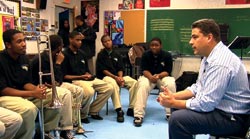
Dean of the Conservatory David H. Stull talks with students from Camden City Creative Arts High School, which has a highly successful music program.
(Photo by Daniel Schloss ’07)
In Fall of 2009, I enjoyed the privilege of a sabbatical from Oberlin and initiated a project with two objectives: to observe K-12 music programs across the country in order to better understand the current state of music education; and to interview artists with careers of enduring importance to gain their perspectives on music and the profession. The first of these endeavors provided insight into the transformative power of music education for children living in very different communities across the country and led to the launch of an exciting new program at Oberlin, Music in America.
My journey across the United States was undertaken in a 1957 Cessna Skylane with my colleague Daniel Schloss, conservatory videographer and intrepid passenger. What follows is a brief chronicle of two extraordinary visits and details on the launch of Music in America and our vision for the future.
Camden, New Jersey
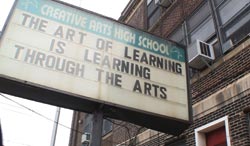
Camden City Creative Arts High School’s sign is an encouraging reminder for students.
(Photo by Daniel Schloss ’07)
There may be no two areas of the United States that differ more from one another than Camden, New Jersey and Argyle, Texas. The first suffers from one of the highest violent crime rates in the country and the other has a median family income of just over $90,000. Both have public schools, both have great music programs, and both have children who need them.
Jamal Dickerson is not a typical band director; he was raised in Camden, and became a musician and martial arts expert. Unlike many growing up in Camden, he had the privilege of knowing both parents. His dad started a community program to help children in the city and Jamal committed himself to a similar life path, but through public music school teaching following his certification at Morgan State University.
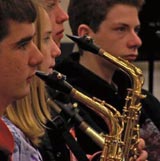
Students at Argyle High School in Texas rehearse.
(Photo by
Daniel Schloss ’07)
The Camden City Creative Arts High School does not glisten nor invite you into its midst. It is a fortress-like structure that once served as a school for girls. Today, this gritty block of concrete extends its bulwarks with a chain link fence and mercury lights. The metal detector seems almost quaint after passing through the external barrier. From the outside, one might expect a military school at best, or depressing violent chaos at worst. Both assumptions would be wrong.
The school is alive with music and is a haven for children in this community. With a miniscule budget under constant strain and in a city of extreme crime and poverty, the school is achieving something quite remarkable: In a public school system with a 56 percent high-school graduation rate, 100 percent of CAHS students graduate. In Dickerson’s music program, more than 90 percent then go on to college.
The Camden City Creative Arts High School does not glisten nor invite you into its midst. It is a fortress-like structure that once served as a school for girls. Today, the gritty block of concrete has extended its bulwarks with a chain link fence and mercury lights. The metal detector at the entrance seems almost quaint after you pass through the external barrier. From the outside, one might expect a military school at best or depressing violent chaos at worst. Both assumptions would be wrong.
The school is alive with music, and most importantly, is a haven for children in this community. With a miniscule budget under constant strain, in a city living with extreme crime and poverty, something quite remarkable is happening here: more than 90% of the students in Dickerson’s program are going to college.

Videographer Daniel Schloss ’07 and Dean David H. Stull in flight.
(Photo by
Daniel Schloss ’07)
The high school, which was selected by U.S. News & World Report as a Bronze Medal winner in its 2008 rankings, seeks to provide compelling experiences and opportunities for its diverse student population. The goal is to empower students, so they can achieve academic excellence through the arts. Its award-winning ensembles, both vocal and instrumental, are the school’s hallmarks.
The first thing you see in the music room is a large board with a list of students who have matriculated at colleges across America. These are names of honor on a list everyone wants to join. The opening rehearsal might begin with a discussion about Miles Davis, J.S. Bach, or a lecture on the necessity of good nutrition. Regardless of the topic, students are engaged - highly engaged. Jamal Dickerson (Mr. D) has created an environment in which music has become the social fabric for students’ lives. They want to be in the band room and this place is home for many of them.

Stull flew this 1957 Cessna Skylane across the country.
(Photo by
Daniel Schloss ’07)
Dickerson has a core belief: music is a critical part of the human experience and every child should have access to it. His agenda, however, is much larger than introducing children to music. He sees his program as a means to transform students’ lives and to develop patterns of lifelong success. His expectations are clear and direct: you will be your best; you will commit yourself to hard work; you will value and respect yourself and others; you will learn to take risks and express yourself; you will do well in your academic classes. And as a matter of understanding, you will go to college.

The acclaimed composer, conductor, and pianist John Williams met with Stull to discuss the Music in America program during a stop in California.
(Photo by
Daniel Schloss ’07)
Dickerson is very specific and thoughtful in his approach. He knows how to establish a continuous rapport with students and he intentionally uses music to inspire them and to develop the skills needed for success. In order to maintain a consistently engaged culture, he often schedules events during the evening and during the summer. Over the last few years, Dickerson has launched a summer peer mentorship program in which high school students are paid to teach eighth graders throughout the district. When asked about this program, Dickerson says that he cannot risk “losing” these kids over the summer, and yet all of them need to work. After raising a few thousand dollars for salaries, he was able to convince guardians to let their children work as teachers, thus fostering leadership and mentorship skills while recruiting a future batch of students.
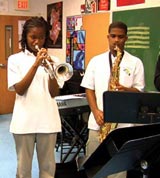
Students at Camden City Creative Arts High School in an ensemble rehearsal.
(Photo by
Daniel Schloss ’07)
Jamal believes that the essential elements of individual success are all taught through music: focus, discipline, cooperation, independent work, complex problem solving, courage, time management, self-reliance, and how to perform under pressure. He inspires all of them to seek excellence and to raise their expectations of themselves. He gives them hope and confidence, and his approach is tremendously successful.
Argyle, Texas
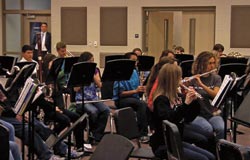
Stull observes a rehearsal at Argyle High School in Texas.
(Photo by
Daniel Schloss ’07)
Principal Jeffrey Butts is not your traditional advocate of music programs. As a former football coach in Texas, he understands the reality of the Friday Night Lights and has spent many years coaching kids and winning games. Argyle High School sits a bit off the road in the middle of Texas horse country. Nearly every parent with a student in the band program is part of the band boosters, and just recently they built a new marching band tower for the school, raising all of the money from local families. The facilities for music instruction are excellent. The school is exceedingly well equipped, a rival for many collegiate music programs. The faculty is outstanding.

Stull and Argyle High School Principal Jeffrey Butts (at right), who believes music teaches students both preparation and accountability.
(Photo by
Daniel Schloss ’07)
Principal Butts is casual in his conversation and yet there is a focus and energy that is readily apparent in his manner. When asked about his view of the music program at Argyle, his response is direct: “As a football coach, I did not think very much about the band program. It was simply not something that attracted my attention. Now I would tell you it is the one of the most important programs in the school.”

In his view, the music program is critical because it teaches the one thing he insists every student must know before graduating: “accountability.”
Foundation Academy is an independent, “No Excuses” college preparatory middle school in Trenton, New Jersey. Opened in August 2007, it serves more than 200 students in grades 5-8 and plans to expand to grades K-12 over the next decade. Its mission is to ensure that all students secure the academic knowledge and skills to prepare them for the nation’s finest colleges, and to instill in them the core values of caring, respect, responsibility and honesty. Foundation Academy requires that every student plays a string instrument; consequently they have an extremely strong music program that is valued by the entire community.
(Photo by Jody kerchner)
He went on to say that while high school football is a great sport, “you have the boys on the field and the boys on the bench, and in Texas, there is one particular thing that matters in football: winning. So, the boys on the field play the games, and the other young men remain on the bench. The great thing about the band is the band has no bench.” Simply stated, every student in the music program feels the obligation to perform well. They all rely on each other, and no one escapes the challenges of preparation and the accountability of performance.
The Initiative Takes Flight
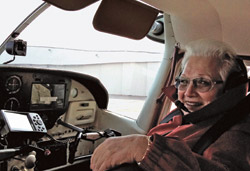
Opera legend and Visiting Distinguished Professor of Voice Marilyn Horne accompanies Stull on a brief flight around Oberlin. Horne piloted the plane for most of the flight.
(Photo by David H. Stull)
When comparing these two schools, it is striking that both serve critical functions in the education of students from radically different demographics. But it is readily apparent how the program in Argyle is an integral part of a robust support structure for students, while the music program in Camden is a critical lifeboat in a dangerous place, perhaps the only one that can take children beyond their circumstances. In recognizing the power of what is being accomplished in Camden New Jersey, and Argyle, Texas, it raises the question of why the music program is often the first thing eliminated by local school boards, and perhaps more importantly, why are we not promoting access to music as part of a required national curriculum?
Considering the challenges in the world today and imagining the solutions for tomorrow, it is clear that successful individuals will need to be disciplined and creative, while retaining the ability to solve complex problems and work effectively with a team, usually under a great deal of pressure. Certainly accountability is a major component of any position. Beyond the belief that every child should have access to educational opportunities in music as an essential part of human development and expression, it also clear that well-executed music programs can have enormous impact on teaching complex skills and facilitating student development in a broad range of areas.
“Oberlin is the most fabulous school, and it just gives me enormous thrill... I get my jollies out of coming here to teach.”
— Marilyn Horne"
For students in impoverished underserved areas, a more urgent concern arises relative to fielding K-12 programs that can retain students and empower a college-bound culture. Any school situated in a challenging environment needs something to create a magnetic and powerful social fabric, the platform that must exist for trust, engagement, self-development, learning, and transformation. If music has the capacity to bind students to schools and promote academic success and the development of critical skills, we should intentionally harness its power.
When considering these issues, it is clear that all of us must engage in the effort to make available superb music education programs to all children throughout the United States. Federal, state, and local governments need to begin an even greater effort to provide high-quality education to our citizenry, and individuals must get more involved. While this is an extraordinarily complex problem, it is in taking specific actions that we might begin to solve it.
For Oberlin, the question is how a major conservatory of music can leverage its program, its position, and its voice such that we can tackle these challenges. In my view, we do an excellent job in preparing educators to enter a program similar to that of Argyle, TX, and in fact throughout the country and the world; but we have never intentionally prepared teachers to enter into challenging urban and disadvantaged areas with the ambitious objective of using music to create a magnetic and positive social fabric and to empower a college-bound culture. To that end, I am proud to announce the launch of Music in America at Oberlin—an initiative designed to partner with our legendary music education program to support, create, and proliferate innovative and successful K-12 music programs such as those found in Camden, Argyle, and in many schools across the country.
The Music in America at Oberlin (MIAO) program seeks to establish and recognize bold and successful music programs in urban and underserved communities throughout the United States with a specific focus on education. It will also introduce, nationally, the broader agenda of using music to bind students to academic programs, thus creating a positive framework for success, achieving strong academic results, cultivating critical life skills, and increasing both retention and college-bound rates.
The Music in America at Oberlin (MIAO) program seeks to establish and recognize bold and successful music programs in urban and underserved communities throughout the United States with a specific focus on education. It will also introduce, nationally, the broader agenda of using music to bind students to academic programs, thus creating a positive framework for success, achieving strong academic results, cultivating critical life skills, and increasing both retention and college-bound rates. The program also seeks to aggressively monitor the efficacy of these programs through implementing assessment strategies.
Selected faculty who are currently achieving these goals in K-12 schools will be named as Music in America Fellows and be invited to the Oberlin campus each year to work directly with our students and, most importantly, to document their strategies so that they can be integrated into a broader curriculum. The Music in America Fellows will be conjoined into a network so that they will have a support system for themselves and their ideas. The program will also provide a forum for discussion and a clearing-house for new strategies, with the hope of influencing other training programs in music education beyond our own.
Oberlin will seek to support the Music in America Fellows by building financial resources that support scholarships, in addition to soliciting the donation of instruments, creating a website for free music that meets the needs of varying talent and instrumentation, and by providing stipends when possible to assist fellows to support their programs. These fellows will also become scouts for potential music educators that emerge from these communities, as there is no doubt that individuals who have personally engaged the specific culture of a given community have a significant advantage when returning to teach there. Oberlin will continue to aggressively build scholarship resources to serve music education students and funds to support music education faculty and fellows in the program.
The ultimate goal is to develop a model that becomes a national beacon for tackling problems in education and that broadly influences the agenda for preparing and supporting all our children for the economy and world of the future. We need to move in this direction, and if we do, I firmly believe we can shape a powerful new vehicle for education and success for our children in the twenty-first century.
It is time for all of us to get off the bench.
David H. Stull ’89 has served as dean of the Oberlin Conservatory of Music since July 2004.
Pilot Grant Makes Music in
America Possible
The Music in America at Oberlin program is made possible through a generous pilot grant given by Alan Korest of Naples, Florida. Korest and his late wife, Marilyn Bower Korest, were introduced to the Oberlin Conservatory of Music through the late Fenner Douglass, who served as professor of organ here from 1949 through 1974.
The Korests, both Michigan natives who retired to Naples, have made music education a key focus for their philanthropy. In addition to the Music in America program, they have founded a number of large-scale musical initiatives.
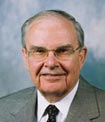
Alan Korest
Among them is the creation of the Bower Chapel at Moorings Park, which is anchored by the Taylor and Boody organ named for Douglass in recognition of his important work in its selection. Concerts there have become mainstay of culture in Southwest Florida and beyond.
In addition, the Korests in 2008 established the Bower School of Music at Florida Gulf Coast University in adjacent Lee City. Currently, 150 students are enrolled in the program and, as in Camden, Trenton, and Argyle, music has served as a beneficial tool in guiding students toward promising futures. The Bower School focuses on music education and performance and will soon add music therapy as a program of study. Dean of the Oberlin Conservatory David H. Stull serves on its advisory board.
The Bower School also is involved in the Guadalupe Program, a community violin curriculum for dramatically underserved pre-K students that is staffed by Bower School students. Designed as a literacy program, it offers twice-weekly lessons that teach students fundamentals, such as how to handle a violin and the purpose of string bows, as well as how to sight-read and play simple songs. The program’s significant, positive impact on the ease of the students’ transition to kindergarten is well documented. A recent documentary details the transformation of the children taking part in the program.
"I love to see music serve as an important vehicle for making education more accessible and relevant," says Korest. "That’s why I’m delighted to be involved in Music in America at Oberlin."
Marci Alegant has stepped down from her position as associate dean of the conservatory to serve as executive director of Music in America at Oberlin. She coordinated the first annual MIAO conference held July 8-10. To learn more about teh conference and Music in America at Oberlin, visit www.oberlin.edu/musicinamerica. Alegant can be reached at malegant@oberlin.edu.
